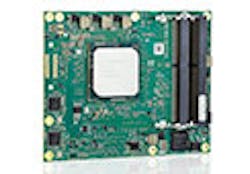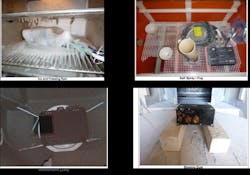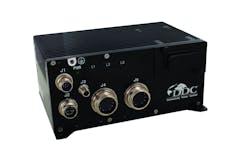COMe Modules Deliver Outstanding Computing Performance
Accelerating Rugged Small Defense Systems Designs
Author: Mark Littlefield, Defense Vertical Product Manager at Kontron America - an S&T Company
When one hears the words “defense computer board” one normally thinks of a computer module that slides into a chassis slot like VME or more recently VPX. However, there is another board type that is being increasingly applied to defense computing systems. This form factor is called COM Express (or COMe for short).
Originally designed as a cost-effective small form factor embedded module for markets like industrial automation, transportation, and test and measurement, COMe has found footing in defense applications where a single processor provides the necessary computing power, but which require a mix of high-performance (such as PCI Express) and standards-based I/O (such as USB or Display Port/HDMI video). As it support processors ranging from an Intel Atom at the low-end to an Intel Xeon-D or Kaby Lake Core i7 on the high end, COMe can meet a broad range of missions and space, weight, and power (SWaP) constraints. Through the use of extended temperature components and smart packaging design, COMe systems have been developed to operate in tough temperature and shock/vibration environments such as track vehicle, helicopters, and high-altitude UAVs.
COMe: What Is It?
COMe was designed to deploy in a compute module/carrier configuration, with standard defined connectivity between the two printed circuit boards (PCBs). There are four different board sizes (Mini: 84 x 55 mm, Compact 95 x 95 mm, Basic: 95 x 125 mm, and Extended 110 x 155 mm, although Extended is not commonly implemented) and 7 connector types (although only types 6, 7, and 10 are in common use today), which sounds like a dizzying array of options, but in practice boils down to a small set of size vs. features:
Table 1: COMe size and connector types
These four different types can be generally characterized as:
Table 2: COMe type comparison
COMe: Where Is It Used?
This mix of compact size and rich I/O complement in a standardized connector arrangement has made COMe a go-to form factor when designing an embedded computing solution within tight space constraints. Its deployments cover the full range of embedded computing environments including factory automation, medical devices, automotive, avionics, rail, digital signage, and defense applications. The result of this means that the COMe product space is constantly growing and evolving to meet market demands with the introduction of new generations of processors, and relatively large production volumes means that COMe based solutions are typical more affordable than other form factors.
However, defense applications require products that can survive and continue to operate reliably in demanding environments. Defense electronics must contend with extreme temperature swings, tough shock and vibration, humidity and salt fog, and lightning transients. To meet these challenges, Kontron adapts key COMe modules with extended temperature parts, ECC memory, and occasionally EMP production to meet the needs of these types of systems. An example of one of these modules is the COMe-bSL6R ES2 (https://www.kontron.com/downloads/datasheets/c/come-basic/come-bsl6/come-bsl6-e2s_20180213_datasheet.pdf?product=144173), featuring a 6th-generation Intel Skylake processor.
COMe: How To Use It For Your Application
COMe modules are typically used with a carrier card that makes use of the signaling that the COMe module provides. These carriers may include connectors for in-system devices or offboard communication such as SATA, Ethernet, or USB, on-board peripheral devices, or standards-based slots such as XMC, mini-PCI Express (mPCIe) or mSATA. The range and variety of options are almost endless due to the PCIe ports provided by COMe.
This two-board stack is then typically packaged in a matter appropriate for the deployed environment. While many markets such as industrial computing can often fans or even simply ventilated or lightly packaged enclosures (such as Kontron’s K-Box series https://www.kontron.com/products/systems/industrial-computers) , defense applications typically require tightly sealed enclosures, often without any fans to assist with cooling. As a result, the compute stack must typically be packaged with heat frames for key components (like the processor and other large power consumers) to provide a path for heat to escape to the outside environment. Designing these thermal solutions can be difficult and time consuming.
While it is completely possible for an application system designer to develop a custom carrier board and packaging solution using COMe, it is often better to start with an existing system and modify it for one’s needs. That is the concept behind COBALT. Kontron has designed the COBALT mission computer to be easily customized to meet a wide range of deployed applications.
Table 3: COBALT - COMe-based mission computer for defense and avionics applications
COBALT is based on a COMe carrier card designed to support either a Compact or Base Type 6 COMe module. This carrier card also provides a full range of front-panel I/O and onboard expansion in the form of mPCIe slots, XMC, and other peripherial device expansion options. Natively the baseline COBALT provides front-panel connectors with a typical content of video and communications ports (USB, Ethernet, serial, GPIO, etc.). COBALT also has peripheral features such as removable and fixed solid state drives and multiple heatsink options. All this makes COBALT an extremely flexible platform for building a deployable customized mission computer. Download the white paper.
The baseline COBALT has gone through a range of MIL-STD and DO-160 environmental and emissions/susceptibility qualification testing. While it’s understood that a platform that has been modified to meet specific mission requirements must normally undergo qualification testing to ensure that requirements are being met, having a pre-qualified platform to build from increases confidence that the final configuration will pass these tests. To this end, COBALT has successfully deployed to numerous ground vehicle and aircraft-based platforms in both military and commercial avionics applications.
Table 4: COBALT undergoing environmental testing
COBALT has an ever-growing list of off-the-shelf catalog configurations. However, should one of those catalog configurations not exist, it can be modified to meet your particular mission requirements. For instance, adding a specific interface may be as simple as adding an XMC or mini-PCIe adapter, developing a cable harness and front-panel connector assembly, and modifying the standard front-panel to accommodate the new connector. Other modifications are also possible like developing a custom signal interface board and front-panel to meet specific connector requirements, or even modifying the chassis to allow a custom module to be integrated. An example of this latter modification is the Hughes HM200 satellite modem system in which a COBALT was modified to integrate a custom Hughes module.
Table 5: Hughes HM200 system based on COBALT
The versatility of COMe for building rugged deployable military systems is clear. The insatiable demands of the industrial computing market means that there is a constant race to integrated the latest processors onto COMe modules, which means that there are always COMe modules available with the latest-generation of processors. COMe is quickly becoming one of the must-have tools in many defense system integrators toolboxes.





